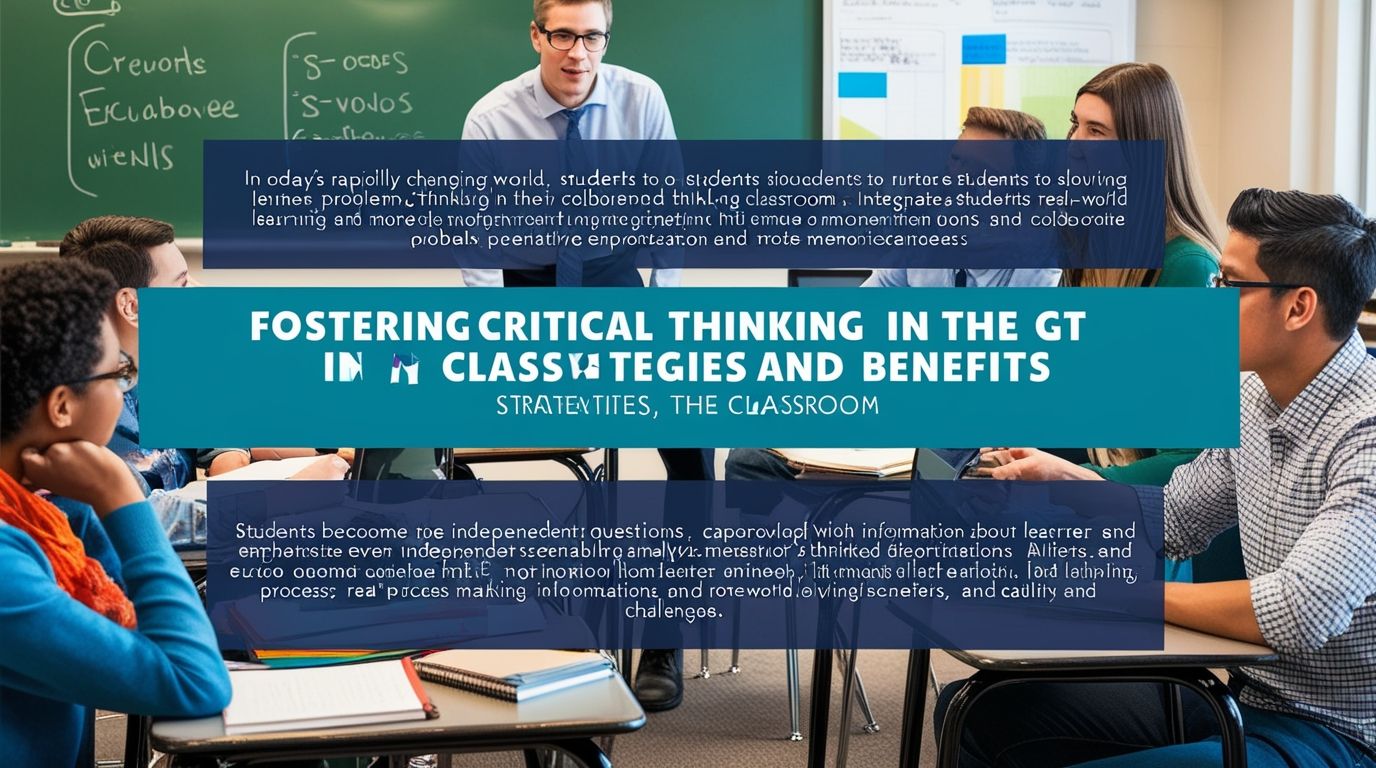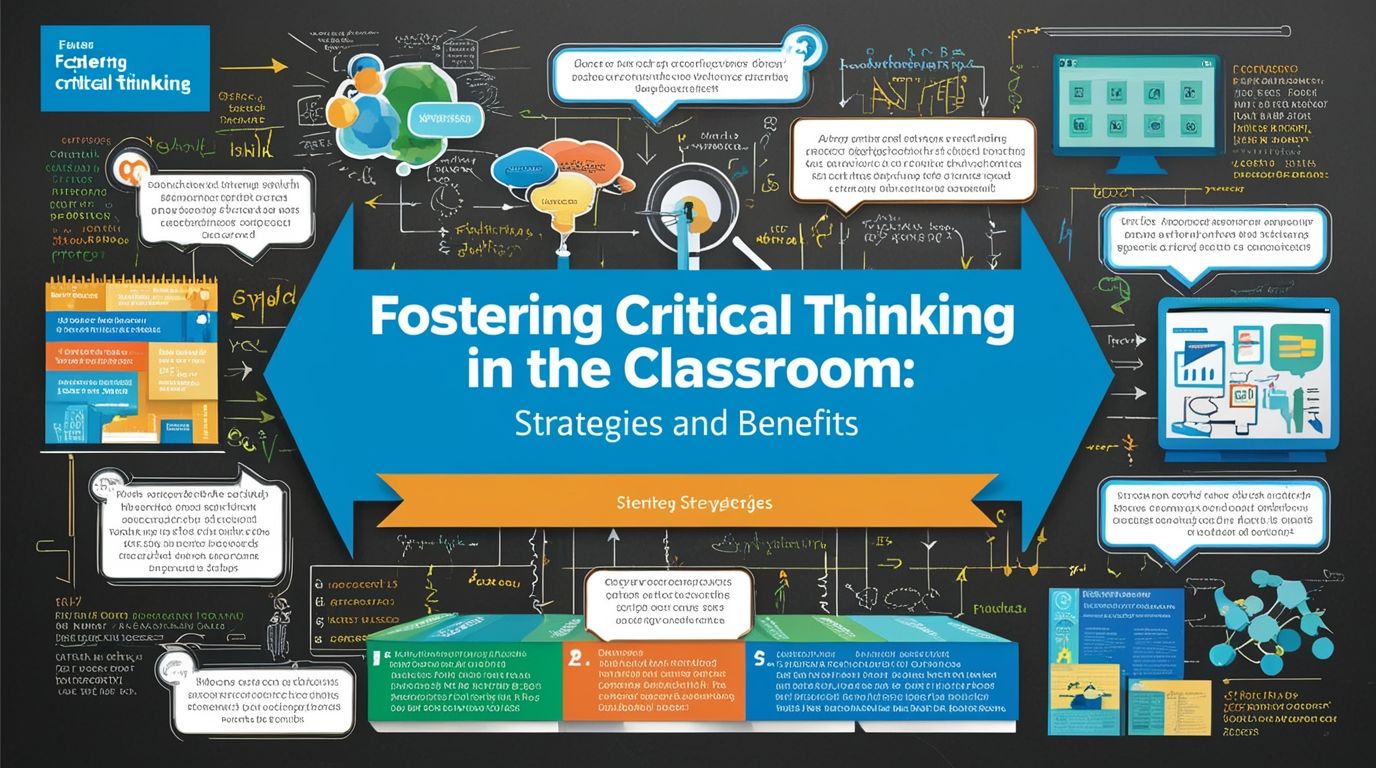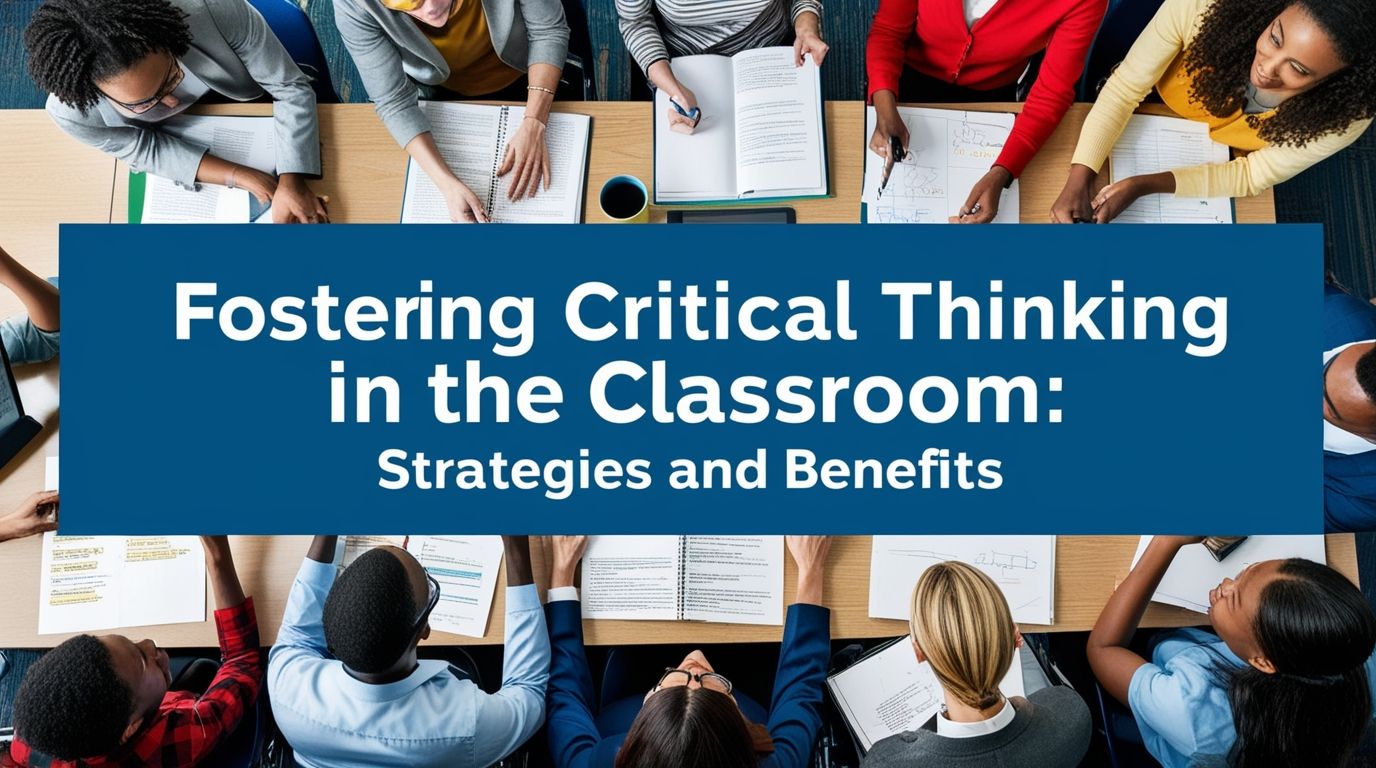Fostering Critical Thinking in the Classroom is an essential skill that students need to develop to navigate the complexities of the modern world. It involves analyzing information, evaluating evidence, and making reasoned judgments. Cultivating critical thinking skills in the classroom not only enhances academic performance but also prepares students for real-life problem-solving and decision-making. This article explores the importance of critical thinking, strategies for fostering it in the classroom, and the benefits of a critical thinking-focused educational approach.
The Importance of Critical Thinking
Critical thinking is the ability to think clearly and rationally, understanding the logical connection between ideas. It involves:
- Analysis: Breaking down complex information into manageable parts.
- Evaluation: Assessing the credibility and relevance of information.
- Inference: Drawing conclusions based on evidence and reasoning.
- Explanation: Clearly articulating reasoning and evidence.
- Self-Regulation: Reflecting on one’s own beliefs, thought processes, and conclusions.

Developing critical thinking skills is crucial because:
- Enhanced Academic Performance: Critical thinkers can analyze and understand complex materials, leading to better academic outcomes.
- Problem-Solving Skills: These skills are essential for identifying problems, generating solutions, and making decisions.
- Informed Citizenship: Critical thinkers are better equipped to engage in democratic processes and make informed decisions about social and political issues.
- Lifelong Learning: Critical thinking fosters a love of learning and an ability to adapt to new information and changing circumstances.
Strategies for Fostering Critical Thinking
Implementing critical thinking in the classroom requires intentional strategies and practices. Here are several effective methods:
1. Socratic Questioning
Socratic questioning involves asking open-ended questions that stimulate critical thinking and dialogue. This method encourages students to explore complex ideas and develop their own understanding.
- Examples of Socratic Questions:
- What evidence supports this argument?
- How would you interpret this data?
- Can you explain your reasoning?
- What are the implications of this idea?
2. Problem-Based Learning (PBL)
Problem-based learning involves presenting students with real-world problems to solve. This approach promotes critical thinking by requiring students to research, collaborate, and apply their knowledge.
- Steps in Problem-Based Learning:
- Present a problem or case study.
- Allow students to define the problem and identify what they need to learn.
- Facilitate research and information gathering.
- Encourage group discussions and collaborative problem-solving.
- Have students present their solutions and justify their reasoning.

3. Debate and Discussion
Debates and discussions provide opportunities for students to articulate their ideas, challenge others, and defend their positions. This fosters critical thinking by promoting the analysis and evaluation of different viewpoints.
- Tips for Effective Debates and Discussions:
- Choose relevant and engaging topics.
- Establish clear rules and guidelines.
- Encourage respectful and constructive dialogue.
- Require students to support their arguments with evidence.
- Facilitate reflection on the discussion process and outcomes.
4. Case Studies and Simulations
Case studies and simulations immerse students in real-life scenarios, requiring them to apply critical thinking skills to analyze situations, make decisions, and solve problems.
- Implementing Case Studies and Simulations:
- Select or create realistic scenarios relevant to the subject matter.
- Provide background information and context.
- Encourage students to analyze the situation and identify key issues.
- Facilitate group discussions and decision-making processes.
- Debrief and reflect on the outcomes and lessons learned.
5. Reflective Journals
Reflective journals allow students to articulate their thought processes, reflect on their learning experiences, and develop self-regulation skills.
- Guidelines for Reflective Journals:
- Encourage regular and consistent entries.
- Provide prompts that stimulate reflection on learning and thinking processes.
- Offer feedback that guides deeper reflection and critical analysis.
- Use journals as a basis for one-on-one discussions or conferences.
Benefits of Fostering Critical Thinking
Integrating critical thinking into classroom practices yields numerous benefits for students:
1. Improved Academic Performance
Students who develop critical thinking skills tend to perform better academically. They can analyze and synthesize information, understand complex concepts, and produce higher-quality work.
2. Enhanced Problem-Solving Abilities
Critical thinking equips students with the tools needed to tackle complex problems. They can identify issues, generate potential solutions, evaluate alternatives, and implement effective strategies.
3. Increased Engagement and Motivation
Engaging students in activities that require critical thinking can increase their interest and motivation. They become active participants in their learning, taking ownership of their education and pursuing deeper understanding.
4. Better Communication Skills
Critical thinking activities often involve discussion, debate, and presentation, helping students develop strong communication skills. They learn to articulate their ideas clearly, listen to others, and engage in constructive dialogue.
5. Preparation for Future Challenges
Critical thinking prepares students for the uncertainties and complexities of the future. Whether in higher education, the workforce, or civic life, individuals with strong critical thinking skills are better equipped to navigate challenges and make informed decisions.

Overcoming Challenges in Fostering Critical Thinking
While the benefits of fostering critical thinking are clear, educators may face several challenges:
1. Time Constraints
Incorporating critical thinking activities can be time-consuming. Teachers need to balance the demands of the curriculum with the time required for deep, reflective thinking.
- Solution: Integrate critical thinking into existing lessons and activities. Use short, focused activities that fit within the regular class schedule.
2. Assessment Difficulties
Assessing critical thinking skills can be challenging, as they are not easily measured by traditional tests.
- Solution: Use a variety of assessment methods, such as rubrics, reflective journals, and performance-based tasks. Provide clear criteria and constructive feedback.
3. Student Resistance
Some students may resist critical thinking activities, especially if they are used to more passive forms of learning.
- Solution: Gradually introduce critical thinking activities, starting with simpler tasks and building up to more complex ones. Explain the benefits and provide support and encouragement.
4. Teacher Preparation
Teachers may need additional training and support to effectively foster critical thinking.
- Solution: Provide professional development opportunities focused on critical thinking strategies and best practices. Encourage collaboration and sharing of resources among teachers.
Conclusion
Fostering critical thinking in the classroom is essential for preparing students for the challenges of the modern world. By implementing strategies such as Socratic questioning, problem-based learning, debates, case studies, and reflective journals, educators can cultivate these vital skills. The benefits of critical thinking extend beyond academic performance, enhancing problem-solving abilities, communication skills, engagement, and motivation. Despite the challenges, with thoughtful planning and support, educators can create a classroom environment that promotes and values critical thinking, ultimately leading to more successful and well-rounded students.

n7y7se
I was suggested this web site by means of my cousin. I am no longer certain whether this post is written by means of him as no one else recognise such targeted about my problem. You are incredible! Thanks!
Way cool! Some extremely valid points! I appreciate
you writing this post and also the rest of the site is also very good.
Visit my web page Nordvpn Coupons Inspiresensation
of course like your website but you need to take a look at the spelling on quite a few of your posts. Several of them are rife with spelling problems and I to find it very troublesome to tell the truth then again I¦ll definitely come again again.
I’ll immediately clutch your rss as I can not find your e-mail subscription hyperlink or e-newsletter service. Do you’ve any? Kindly permit me know so that I could subscribe. Thanks.
You have brought up a very fantastic details , thankyou for the post.
Thank you for sharing with us, I believe this website genuinely stands out : D.
Youre so cool! I dont suppose Ive read something like this before. So nice to search out somebody with some unique ideas on this subject. realy thank you for beginning this up. this web site is something that is needed on the net, somebody with a little originality. useful job for bringing something new to the internet!
Wonderful paintings! This is the type of info that should be shared across the net. Disgrace on Google for now not positioning this put up higher! Come on over and discuss with my site . Thanks =)
Hey very cool website!! Guy .. Beautiful .. Amazing .. I will bookmark your site and take the feeds also?KI am happy to seek out so many helpful information right here within the publish, we want develop more strategies on this regard, thanks for sharing. . . . . .
I think this is one of the most vital info for me. And i am glad reading your article. But wanna remark on some general things, The site style is perfect, the articles is really excellent : D. Good job, cheers
I conceive this site contains some really great information for everyone : D.
I like what you guys are up too. Such smart work and reporting! Carry on the excellent works guys I’ve incorporated you guys to my blogroll. I think it will improve the value of my site 🙂
I am often to blogging and i really appreciate your content. The article has really peaks my interest. I am going to bookmark your site and keep checking for new information.
Thank you, I have recently been searching for info about this topic for a while and yours is the best I have found out so far. But, what about the conclusion? Are you certain concerning the source?
Hiya! I know this is kinda off topic nevertheless I’d figured I’d ask. Would you be interested in exchanging links or maybe guest writing a blog article or vice-versa? My website goes over a lot of the same topics as yours and I feel we could greatly benefit from each other. If you are interested feel free to shoot me an email. I look forward to hearing from you! Great blog by the way!